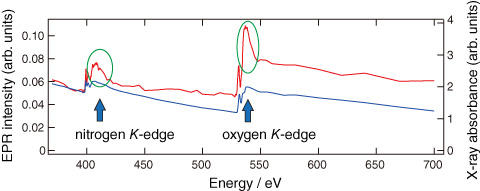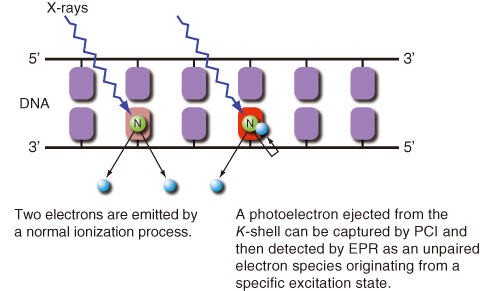
Fig.7-9 Anomalous enhancement of EPR signal at nitrogen and oxygen K-edges

Fig.7-10 K-shell photoabsorption processes at specific atoms in DNA (nitrogen K-shell photoabsorption is shown as an example)
Risk assessment for low-dose irradiation has been one of the most urgent issues. In particular, the research field of radiation damage to DNA coding genetic information and its biological repair has not yet been fully understood. In this study we revealed a novel mechanism of the radiation process in DNA damage.
When a living cell is exposed to ionizing radiation, particularly high-energy charged particles, energy over a wide range is deposited from the particle to the DNA. Depending on the deposited energy level, various DNA damage processes might proceed simultaneously. To fully understand the damage processes, each one should be individually analyzed. Previous studies, however, lacked suitable techniques to realize this goal.
We addressed this difficulty using highly monochromatized soft X-rays. In an irradiated DNA molecule, an unpaired electron remaining in the outermost shell after ionization is one of the short-lived intermediates that cause damage. We exposed DNA to soft X-rays obtained from a synchrotron facility (SPring-8) while sweeping the energy. The precise dependence of the yields of the unpaired electron species on the soft X-ray energy was investigated, particularly around the K-shell ionization thresholds of the DNA constituent atoms nitrogen and oxygen. Previously it was difficult to directly observe the highly reactive and short-lived species. To realize “in situ” observation of the short-lived species, we connected an electron paramagnetic resonance (EPR) apparatus to the soft X-ray beamline.
The result shows that the EPR intensity (![]() line in Fig.7-9) corresponding to the yield of the unpaired electron species changes roughly in proportion to the X-ray absorption probability by K-shell electrons (
line in Fig.7-9) corresponding to the yield of the unpaired electron species changes roughly in proportion to the X-ray absorption probability by K-shell electrons (![]() line in Fig.7-9). Further, exposure to X-rays with an energy slightly above the ionization thresholds causes, very interestingly, an anomalous enhancement of the EPR signal intensity (shown by circles in Fig.7-9). A theoretical analysis revealed that the enhancement is caused by recapturing of an ejected slow electron at the ionized atom through a Post Collision Interaction (PCI) process, which is a novel mechanism of radiation damage to DNA (Fig.7-10).
line in Fig.7-9). Further, exposure to X-rays with an energy slightly above the ionization thresholds causes, very interestingly, an anomalous enhancement of the EPR signal intensity (shown by circles in Fig.7-9). A theoretical analysis revealed that the enhancement is caused by recapturing of an ejected slow electron at the ionized atom through a Post Collision Interaction (PCI) process, which is a novel mechanism of radiation damage to DNA (Fig.7-10).
These results are expected to advance understanding of DNA damage, particularly that originating from K-shell ionization.
This work was supported by a Japan Society for the Promotion of Science (JSPS) KAKENHI Grant-in-Aid for Scientific Research (B) (No.21310041).